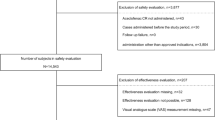Summary
The efficacy and safety of aceclofenac (100 mg bid), a new nonsteroidal anti-inflammatory/anti-rheumatic agent, were compared with those of naproxen (500 mg bid) in a multi-centre, twelve-week, randomized, double-blind, parallel-group clinical trial in outpatients with active osteoarthritis of the knee. 190 patients received aceclofenac, 184 naproxen.
The two treatments were compared on the basis of several characteristic clinical features of osteoarthritis of the knee, including various pain measurements. In both groups, the treatment resulted in a significant reduction of the pain at rest, pain on movement and the pain from pressure on the joint, 76–86% of aceclofenac patients reporting reduction in pain after 12 weeks. Three-quarters of the aceclofenac-treated patients had an accompanying reduction in joint swelling and 81.4% in knee function capacity, up to complete freedom of movement. Joint stiffness, which at baseline lasted 20 minutes, was reduced in the aceclofenac group to 10 minutes. A statistically significant difference in the efficacy of the two drugs was not found. The 34 adverse drug effects documented in 24 (12.6%) of the aceclofenac patients were fewer than the 43 events in 30 patients (16.3%) reported for naproxen. The trend towards better tolerability of aceclofenac manifested itself above all in a lower total incidence of gastrointestinal side-effects.
Aceclofenac is as effective as naproxen in the symptomatic treatment of osteoarthritis of the knee and is well tolerated in general.
Similar content being viewed by others
References
Grau M, Guasch J, Montero JL, Felipe A, Carrasco E, Julià S. Pharmacology of the potent new nonsteroidal anti-inflammatory agent aceclofenac. Arzneim-Forsch/Drug Res 1991, 41, 1265–1276.
Cecchetin M, Cerea P, Torri G. Therapeutic efficacy of aceclofenac and diclofenac in acute knee arthroses. Study of the E2-Prostaglandin levels in the synovial fluid and in the serum. Clin Trials J, 1988; 25: 144–151.
Torrejón VA. Treatment of severe rheumatic pain with aceclofenac. Results of a comparative study vs placebo. Acta Ther, 1988; 14: 275–280.
Ballesteros R, Ansoleaga JJ, Tapounet R. The efficacy and tolerance of aceclofenac in rheumatoid arthritis. A double-blind study vs placebo. Clin Trials J, 1990; 27: 12–19.
Giorgianni G, Ottaviani C, Soliano A, Campi N. Efficacy and tolerability of aceclofenac versus ketoprofen in the treatment of rheumatoid arthritis. Curr Ther Res, 1992; 51: 175183.
Dawson AJ, Roma J, Bowdler JM. Aceclofenac in the treatment of rheumatoid arthritis: a multicentre, double-blind, randomised placebo-controlled study. Eur J Rheumatol Inflam. In press.
Martín-Mola E, Gijón-Baños J, Ansoleaga JJ. Aceclofenac in comparison to ketoprofen in the treatment of rheumatoid arthritis. Rheumatol Int. In Press.
Hunter JA, Parnham MJ, Gras X. Aceclofenac in rheumatoid arthritis: a useful and novel anti-inflammatory. Clin rheumatol. In press.
Dias C, Rodriguez A, Geli C, Llobet JM, Tapounet R. Comparison of aceclofenac and diclofenac in osteoarthritic pain. Curr Ther Res, 1988; 44: 252–256.
Grupo de Estudio de Gonartrosis. Eficacia y tolerancia de aceclofenac en el tratamiento de la gonartrosis. Rev Esp Reumatol, 1992; 19: 142–146.
Birrell DH, Roma J, Bowdler JM. Evaluation of the efficacy and safety of aceclofenac in the treatment of osteoarthritis. Br J Clin Res 1995; 6: 45–55.
Ward DE, Veys EM, Bowdler JM, Roma J. Comparison of aceclofenac with diclofenac in the treatment of osteoarthritis. Clin Rheumatol. In press.
González E, De la Cruz C, Nicolás R, Egido J, Herrero-Beaumont, G. Longterm effect of non-steroidal antiinflammatory drugs on the production of cytokines and other inflammatory mediators by blood cells of patients with osteoarthritis. Agents and Actions, 1994; 41: 171–178.
Al Arfag A, Davis P. Osteoarthritis 1991. Current drug treatment regimens. Drugs, 1991; 41: 193–201.
Dromgoole SH, Furst DE. Naproxen. Paulus HE, Furst DE, Dromgoole SH, Editors. Drugs for rheumatic diseases. New York, Edinburgh, London, Churchill Livingstone, 1987, 347–364.
Wassif W, Bjarnason I. A comparison on the effects of aceclofenac and diclofenac on gastrointestinal blood loss. Br J Clin Res, 1992; 3: 109–114.
Brandt KD. Osteoarthritis: treatment guidelines. Drug Therapy, 1988; 18: 26–40.
Hamerman D. The biology of osteoarthritis. New Engl J Med, 1989; 320: 1322–1330.
Author information
Authors and Affiliations
Rights and permissions
About this article
Cite this article
Kornasoff, D., Frerick, H., Bowdler, J. et al. Aceclofenac is a well-tolerated alternative to naproxen in the treatment of osteoarthritis. Clin Rheumatol 16, 32–38 (1997). https://doi.org/10.1007/BF02238760
Received:
Accepted:
Issue Date:
DOI: https://doi.org/10.1007/BF02238760




